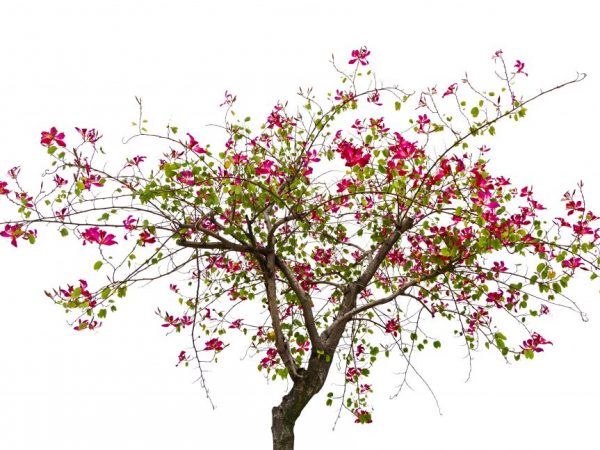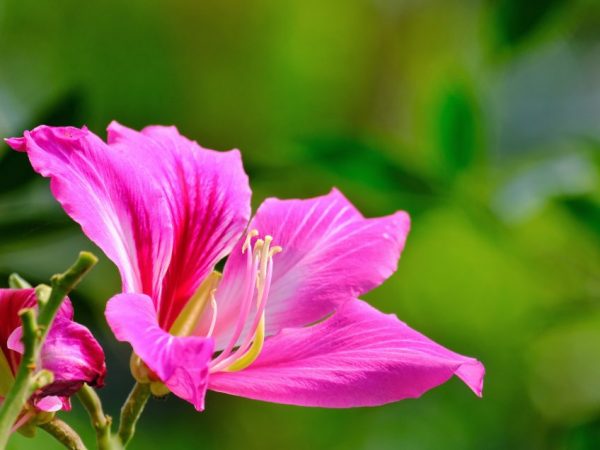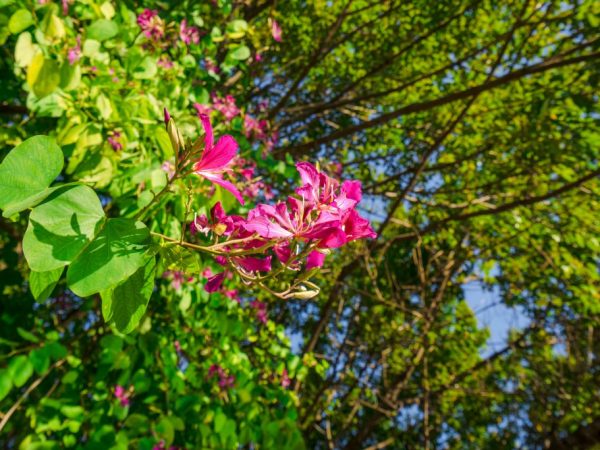Growing a bauhinia orchid tree
The bauhinia orchid tree is an exotic plant that grows up to 10 m in height in its natural environment, more suitable for garden plots in regions with a warm climate. Observing the rules of planting and care, capricious bauhinia can be grown at home.

Growing a bauhinia orchid tree
Biological characteristic
The bauhinia orchid tree belongs to the legume family. It is a representative of the genus of flowering ornamental plants grown to decorate garden and park areas.
The name Bauhinia, or Bauginia, received from the Swiss brothers Baugin. In home gardening, it is called the orchid, or orchid, tree.
When grown at home, bauhinia reaches a height of up to 2 m.At the same time, it develops slowly in a room space.
The trunk is covered with reddish bark. The leaves are often bilobate, consist of 2 double rounded parts with a silvery bloom, the length is up to 12 cm. The flowers outwardly resemble an orchid, up to 15 cm in diameter, have a persistent aroma. The color palette of inflorescences is varied, mainly white and purple. The leaves of the inflorescences can be decorated with stripes, shading or specks. Flowering of individual specimens lasts 1 day, some varieties retain their color for up to 7 days.
Landing
Soil mixture
When growing bauhinia at home, a universal soil used for flower plants is suitable as a soil mixture. The soil mixture is also made independently, which requires:
- 1 part of sheet soil,
- 1 part of turf land,
- 1 part humus
- ½ part of river sand, which is permissible to replace with perlite.
The acidity of the soil needs to be adjusted with the help of river sand, bringing the soil mixture to slightly acidic or neutral.
To grow bauhinia at home, drainage is needed in a pot container.
Fertilizers
Fertilizing complexes are introduced into the soil mixture. They do this at the stage of active growth in the spring, feeding the bauhinia with complexes with nitrogen. This component helps to form new shoots and builds up green mass. In summer, fertilizer complexes should contain potassium and phosphorus. In the fall, fertilization is stopped. This makes it possible for new shoots to mature and harden before the onset of winter.
Landing
Before planting, holes must be made in the pot to drain excess water. The pot is placed on a pallet. Drainage is laid out on the bottom of the pot container, which is suitable for pebbles, brick chips and expanded clay. The drainage layer is covered with soil mixture. A plant placed in a container is showered with soil from all sides and watered.
Pruning and replanting

Beautiful flowers with the right care
Bauhinia care involves pruning and transplanting.
Pruning
Trimming is done without fail, becausethis directly affects the development of bauhinia, and some varieties stop branching without pruning. Initially, the procedure is carried out in the spring, when the plant is 3 years old.
- for the growth of lateral shoots, the plant is shortened to the desired height at a distance of 40 cm,
- after pruning, young shoots are pinched by 2-3 leaves.
In the process of trimming, no more than ¼ of the crown is removed. A crown is often formed from an orchid tree in the form of a bonsai, for which young, but already stiff processes are wrapped with wire for 2-3 months.
Transfer
Young bauhinia are transplanted every year in the spring. Grown plants are recommended to be transplanted into new soil no more than once every 3-4 years. If desired, an adult tree is left in the same container, cutting off its roots and sprinkling the cuts with crushed coal. The voids that appear after trimming the roots are filled with fresh soil mixture.
Large orchid trees are avoided replanting. For them, the upper layers of the soil mixture are changed to fresh ones.
The tree is transplanted into a pot container larger than the previous one.
Reproduction
The orchid tree is propagated from seeds or cuttings.
Seed planting
Seeds for planting are taken from ripe pods and planted in the spring, having previously soaked in water for 2 days, after selecting the largest and swollen ones. The seeds are sown in a suitable soil to a depth of 5 mm.
Seed germination is increased by scarification - erasing a part of the seed coat from one side of the grain, planting the cleaned part upwards.
To create the desired microclimate, the container with planting seeds is covered with polyethylene or glass. The container is placed in a warm, well-lit place. The sprouts are ventilated daily, the soil mixture is moistened with a spray bottle. After 2 years, young seedlings are planted in a permanent place in a separate potting container.
Cuttings
Reproduction by cuttings begins in the spring, for which the branches are cut, which are half stiff. Branches cut during the technological processing of the crown are also suitable as material for grafting.
Fresh sections are treated with a growth-stimulating preparation and the section is planted in vermiculite, covering the planting with polyethylene on top.
Care

The tree only grows in warm regions
Caring for an orchid tree involves creating a suitable microclimate for it.
Temperature regime
The optimum temperature for bauhinia in winter is at least 15 ° С, from spring to autumn - 22 ° С-25 ° С. It is able to withstand short-term temperature drop down to -5 ° C.
Humidity and watering
Bauhinia tolerates a short-term drought, but in the hot season it requires regular watering, especially if it is located in a place well-lit by the sun. Humidity is recommended to be maintained at a level of 75-80%, although the plant does not stop developing at rates of 40-50%. After watering, the top layer of the soil mixture should dry out.
In autumn and winter, watering is reduced to a minimum. During the hot period, the plant is sprayed, avoiding the ingress of water on the flowers and buds.
Location and illumination
A suitable place for the location of the bauhinia is the illuminated south, southeast or southwest of the room. Optimal lighting is bright in the morning and evening hours, shaded during peak solar activity. To extend the duration of daylight hours in winter, they resort to additional lighting.
Flowering care and rest
Bauhinia blooms from early spring to late autumn. When grown in the shade, the flowering process will not be as abundant as when the plant is kept in a bright room. Keep flowering cool and less watering to extend flowering time.
A flowering plant without fail requires feeding.
The dormant period occurs in the winter. For good rest, the bauhinia is placed in the brightest place, the temperature is maintained at 12 ° C-15 ° C, they are not fed, the volume and frequency of watering are reduced to a minimum.
Conclusion
Despite the fact that tropical bauhinia is more often grown in open areas in regions with warm climates, it is possible to grow an orchid tree at home if a suitable microclimate is created for it.


